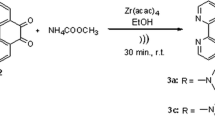Abstract
The bright chemiluminescence has been observed in the system: Co2+/hydrogen peroxide/lucigenin. The chemiluminescence intensity was directly proportional to either cobalt, hydrogen peroxide, or lucigenin concentrations. A procedure of determination of superoxide dismutase (SOD) activity by the chemiluminescence method in the cobalt–hydrogen peroxide–lucigenin system at pH 8.5 is suggested. A linear dependence was established between a relative chemiluminescence intensity and SOD concentration in the range of SOD concentrations between 0 and 4.5 nM, c 1/2 = 0.8 nM. The determination of SOD activity was performed in several tissue samples (rat plasma, erythrocyte hemolysate, and liver mitochondria). A technique of tissue sample preparation with the use of thermal inactivation of interfering proteins at 60 °C was used. The method was successfully applied for comparison of the efficiency of SOD mimetics.


Similar content being viewed by others
References
McCord JM, Fridovich I (1969) Superoxide dismutase an enzymic function for erythrocuprein (hemocuprein). J Biol Chem 244(22):6049–6055
Yao D, Vlessidis AG, Gou Y, Zhou X, Zhou Y, Evmiridis NP (2004) Chemiluminescence detection of superoxide anion release and superoxide dismutase activity: modulation effect of Pulsatilla chinensis. Anal Bioanal Chem 379(1):171–177. doi:10.1007/s00216-004-2527-z
Laihia JK, Jansen CT, Ahotupa M (1993) Lucigenin and linoleate enhanced chemiluminescent assay for superoxide dismutase activity. Free Radic Biol Med 14(5):457–461
Beauchamp C, Fridovich I (1971) Superoxide dismutase: improved assays and an assay applicable to acrylamide gels. Anal Biochem 44(1):276–287. doi:0003-2697(71)90370-8
Ewing JF, Janero DR (1995) Microplate superoxide dismutase assay employing a nonenzymatic superoxide generator. Anal Biochem 232(2):243–248. doi:10.1006/abio.1995.0014
Popov IN, Lewin G, von Baehr R (1987) Photochemiluminescent detection of antiradical activity. I. Assay of superoxide dismutase. Biomed Biochim Acta 46(11):775–779
Misra HP, Fridovich I (1972) The generation of superoxide radical during the autoxidation of hemoglobin. J Biol Chem 247(21):6960–6962
Jewett SL, Rocklin AM (1993) Variation of one unit of activity with oxidation rate of organic substrate in indirect superoxide dismutase assays. Anal Biochem 212(2):555–559. doi:10.1006/abio.1993.1368
Lissi E, Pascual C, Castillo MD (1994) On the use of the quenching of luminol luminescence to evaluate SOD activity. Free Radic Biol Med 16(6):833–837
Okado-Matsumoto A, Fridovich I (2001) Assay of superoxide dismutase: cautions relevant to the use of cytochrome c, a sulfonated tetrazolium, and cyanide. Anal Biochem 298(2):337–342
Nishikimi M, Appaji NR, Yagi K (1972) The occurrence of superoxide anion in the reaction of reduced phenazine methosulfate and molecular oxygen. Biochem Biophys Res Commun 46(2):849–853
Lenaerts I, Braeckman BP, Matthijssens F, Vanfleteren JR (2002) A high-throughput microtiter plate assay for superoxide dismutase based on lucigenin chemiluminescence. Anal Biochem 311(1):90–92
Lvovich V, Scheeline A (1997) Amperometric sensors for simultaneous superoxide and hydrogen peroxide detection. Anal Chem 69:454–462
Mesaros S, Vankova Z, Grunfeld S, Mesarosova A, Malinski T (1998) Preparation and optimization of superoxide microbiosensor. Anal Chim Acta 358:27–33
Peskin AV, Winterbourn CC (2000) A microtiter plate assay for superoxide dismutase using a water-soluble tetrazolium salt (WST-1). Clin Chim Acta 293(1–2):157–166
Naoghare PK, Kwon HT, Song JM (2009) Development of a photosensitive, high-throughput chip-based superoxide dismutase (SOD) assay to explore the radioprotective activity of herbal plants. Biosens Bioelectron 24(12):3587–3593
Simonian MA, Nalbandian RM (1975) Preparation of electrophoretically homogeneous erythrocuprein and its thermodenaturation. Biokhimiia 40(4):726–732
Li Y, Zhu H, Kuppusamy P, Roubaud V, Zweier JL, Trush MA (1998) Validation of lucigenin (bis-N-methylacridinium) as a chemilumigenic probe for detecting superoxide anion radical production by enzymatic and cellular systems. J Biol Chem 273(4):2015–2023
Greenlee L, Fridovich I, Handler P (1962) Chemiluminescence induced by operation of iron-flavoproteins. Biochemistry 1:779–783
Burdo TG, Seitz WR (1975) Mechanism of cobalt catalysis of luminol chemiluminescence. Anal Chem 47(9):1639–1643. doi:10.1021/ac60359a019
Yamashiro N, Uchida S, Satoh Y, Morishima Y, Yokoyama H, Satoh T, Sugama J, Yamada R (2004) Determination of hydrogen peroxide in water by chemiluminescence detection, (I) flow injection type hydrogen peroxide detection system. J Nucl Sci Technol 41(9):890–897
Lucas M, Solano F (1992) Coelenterazine is a superoxide anion-sensitive chemiluminescent probe: its usefulness in the assay of respiratory burst in neutrophils. Anal Biochem 206(2):273–277. doi:0003-2697(92)90366-F
Nakano M (1998) Detection of active oxygen species in biological systems. Cell Mol Neurobiol 18(6):565–579
Afanas’ev IB, Ostrachovitch EA, Korkina LG (1999) Lucigenin is a mediator of cytochrome C reduction but not of superoxide production. Arch Biochem Biophys 366(2):267–274. doi:10.1006/abbi.1999.1215
Liochev SI, Fridovich I (1998) Lucigenin as mediator of superoxide production: revisited. Free Radic Biol Med 25(8):926–928. doi:S089158499800121X
Liochev SI, Fridovich I (1997) Lucigenin (bis-N-methylacridinium) as a mediator of superoxide anion production. Arch Biochem Biophys 337(1):115–120. doi:10.1006/abbi.1997.9766
Maral J, Puget K, Michelson AM (1977) Comparative study of superoxide dismutase, catalase and glutathione peroxidase levels in erythrocytes of different animals. Biochem Biophys Res Commun 77(4):1525–1535. doi:S0006-291X(77)80151-4
Peeters-Joris C, Vandevoorde AM, Baudhuin P (1975) Subcellular localization of superoxide dismutase in rat liver. Biochem J 150(1):31–39
Author information
Authors and Affiliations
Corresponding author
Rights and permissions
About this article
Cite this article
Zhidkova, T.V., Proskurnina, E.V., Parfenov, E.A. et al. Determination of superoxide dismutase and SOD-mimetic activities by a chemical system: Co2/H2O2/lucigenin. Anal Bioanal Chem 401, 381–386 (2011). https://doi.org/10.1007/s00216-011-5070-8
Received:
Revised:
Accepted:
Published:
Issue Date:
DOI: https://doi.org/10.1007/s00216-011-5070-8



